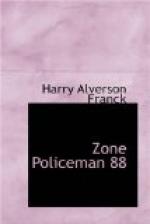“What time does that 6:35 train leave?” I demanded.
“Yo, senor,” he said with ministerial dignity, shifting slowly to the other shoulder, “no tengo conocimiento de esas cosas” (I have no knowledge of those things).
He probably did not know there is a railroad from Panama to Colon. It has only been in operation since 1855.
Later I found the fault lay with my brass watch.
With a perspiration up for all day I set out along the track. Hounding Diablo Hill the realization that I was hungry came upon me simultaneously with the thought that unless I got through the door of Corozal hotel by 7:30 I was likely to remain so. Breakfast over, I caught the morning supply-train to Miraflores, there to dash through the locks for a five-minute interview. I walked to Pedro Miguel and, descending from the embankment of the main line, “nailed” a dirt-train returning empty and stood up for a breezy ride down through the “cut.” It was the same old smoky, toilsome place, a perceptible bit lower. As in the case of a small boy only those can see its growth who have been away for a time. The train stopped with a jerk at the foot of Culebra. I walked a half-mile and caught a loaded dirt-train to Cascadas. The matter there to be investigated required ten minutes. That over, I “got in touch” at the nearest telephone, and the Corporal’s voice called for my immediate presence at headquarters. There chanced to be passing through Cascadas at that moment a Panama-bound freight, the caboose of which caught me up on the fly; and forty minutes later I was racing up the long stairs.
There I learned among other things that a man I was anxious to have a word with was coming in on the noon train, but would be unavailable after arrival. I sprang into a cab and was soon rolling away again, past the Chinese cemetery. At the commissary crossing in East Balboa we were held up by an empty dirt-train returning from the dump. I tossed a coin at the cabman and scrambled aboard. The train raced through Corozal, down the grade and around the curve at unslacking speed. I dropped off in front of Miraflores police station, keeping my feet, thanks to practice and good luck, and dashing up through the village, dragged myself breathlessly aboard the passenger train as its head and shoulders had already disappeared in the tunnel.
The ticket-collector pointed out my man to me in the first passenger coach, the “ladies’ car”—he is a school-teacher and tobacco smoke distresses him—and by the time we pulled into Panama I had the desired information. Dinner was not to be thought of; I had barely time to dash through the second-class gate and back along the track to Balboa labor-train. From the docks a sand-train carried me to Pedro Miguel.




